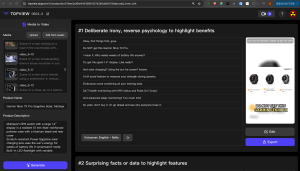AI video editor compare to human editors
Whether you’re an experienced editor or a newbie, using video editing software can save you time and energy. AI-powered video editors make editing easier with automated options, such as color correction and scene identification. They can also remove awkward pauses and unnecessary words, like “uh” or “um”. However, human editors will remain crucial for their creativity and emotional intelligence that AI cannot replicate yet. They can work hand in hand with AI to create compelling videos.
The AI Video Editor is a powerful tool for marketers to understand what works and doesn’t work on the platform. It offers a number of features and functionality, including an analysis of visual elements, ad copy, CTAs, audience targeting parameters, engagement metrics, and overall ad performance. Tiktok’s Ad Library also lets users monitor competitors and identify ad strategies that are working. This can be used to improve ad campaigns, including content development and distribution.
For example, Chipotle utilized the Tiktok ads library to run a lid flip challenge that resulted in 110,000 user-generated videos and 4.5 billion views. The library can also be used to evaluate long-term trends like increases or declines in engagement. Writing a script is one of the most difficult aspects of video production and can stall creative projects before they start. AI video editing tools automate this step, letting editors focus on story development and other elements of creating videos that are meaningful to their audiences.

How does an AI video editor compare to human editors?
Many video editing tools use AI to perform tedious, time-consuming tasks such as transcribing audio, removing awkward pauses, and adjusting video clips’ color temperature. These automations save companies time and money. They also help ensure that all the video footage complies with company guidelines, which can be challenging when working with multiple different video sources.
AI-powered video editing tools are a game changer for anyone in the business of making video. From delivering a consistent tone and style to minimizing human error, these software tools help users create purposeful, impactful video content.
While AI is revolutionizing video content creation, it does not threaten to replace human editors. In fact, the opposite is true: AI can make video editing more accessible and dynamic for both seasoned and novice makers, freeing them up to focus on the cognitive, logical, and creative parts of the job that humans excel at. This partnership between humans and AI allows both parties to accomplish their goals in ways that are best for the audience and the project. The world of video creation is on the cusp of a transformative era. While there are concerns that AI will replace human creativity, the truth is that it’s here to empower it by providing a whole new set of tools and capabilities.
For example, many Tiktok ADS Library help creators slash the time it takes to go from idea to MP4. By using AI, they can turn scripts into videos without having to hire a team or invest in expensive green screens and cameras. Instead, users simply write a script, pick an avatar or model, and record the video. These virtual avatars are becoming increasingly lifelike, allowing them to move and express a range of emotions. They are ideal for presentations, narrated training videos, and internal communication. They can also act as a substitute for camera shy presenters.
In addition, AI can create professional-looking transitions and effects that add impact to any video. The software can even stabilize shaky footage. It can also do text-to-video magic by automatically analyzing a script and generating visuals that align with the message. There are also a variety of other AI-powered features that improve the workflow and efficiency of video editors. These include a speech-to-text tool that can transcribe audio for subtitles, and automatic color grading to match the colors of different clips.
Using AI to automate video editing tasks frees up the time for content creators to allocate their energy to storytelling and creative elements that make their videos stand out. Unlike traditional editing software, which requires a lot of training and knowledge to master, AI-driven tools offer easy-to-use functionality that reduces the learning curve for new editors. Whether they’re assembling a rough cut or removing awkward pauses, video editing can be a long and tedious process without the use of an AI tool. AI-powered tools can speed up the process and help editors streamline tasks by automating repetitive tasks like creating transcripts, adjusting audio levels, and clearing audio background noise.
With this level of automation, creators can rely on AI to create engaging content that aligns with brand guidelines and ensures consistency across all campaigns. This level of consistency helps brands maintain a consistent voice, tone and style that builds trust and fosters brand loyalty among consumers. AI tools also allow content creators to produce high-quality video faster and at a much lower cost than traditional methods. They eliminate the need for expensive equipment, professional actors and human video editors and can generate videos that are up to 50% cheaper than traditional videos.








